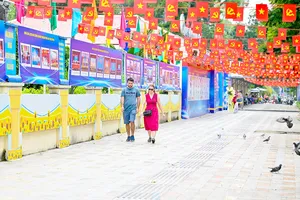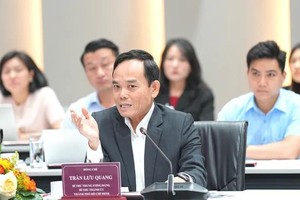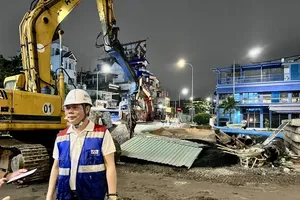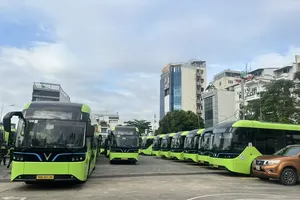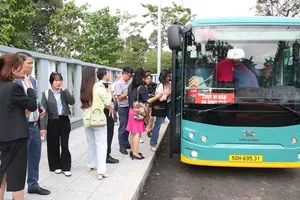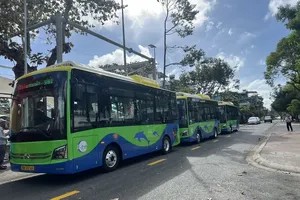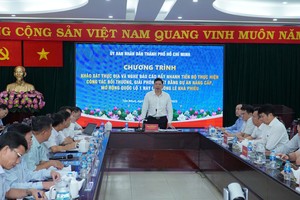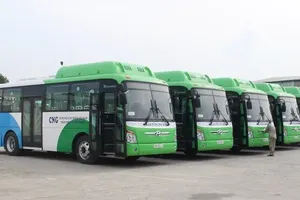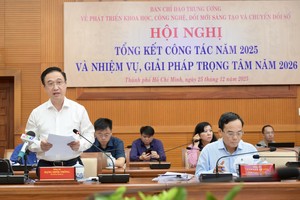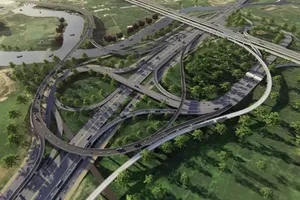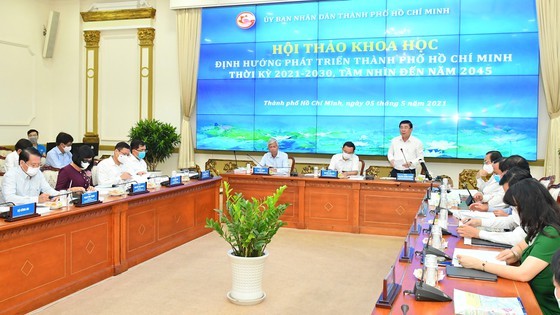
In his opening speech, Chairman of HCMC People’s Committee Nguyen Thanh Phong first mentioned important figures related to the development of HCMC lately.
From 2016-2019, the GRDP of HCMC witnessed an average increase of 7.72 percent per year and contributed over 22 percent to the national GDP as well as over 26 percent to the state budget.
Despite Covid-19 pandemic in 2020, the city still basically fulfilled its missions, with an economic growth of 1.39 percent and the city budget revenue of more than VND371,000 billion (approx. US$16.1 million), accounting for a quarter of the national one.
Remarkably, the ratio of domestic income over the total one in HCMC rose to 71.4 percent last year, which means manufacturing activities in the city are extremely effective, said Chairman Phong.
Observing the resolutions issued in the 13th National Party Congress and the 11th HCMC Party Congress, HCMC is now trying to identify feasible mid-term and long-term goals, along with suitable actions to achieve them.
It is now essential for the municipal leaders to analyze, evaluate, and predict specific development conditions of HCMC in order to take full advantage of all possible potentials of the city. Meanwhile, the city authorities should try different methods to find out practical models and solutions to apply to make more breakthroughs so that HCMC becomes a smart, active, and innovative mega city in the region and the world.
With that in mind, Chairman Phong is welcoming all useful recommendations from experts, scientists, state and local organizations. The planning team will base on them to form a detailed planning strategy for HCMC from 2021-2030, with a vision to 2045, taking into account all challenges of Covid-19 pandemic to the community. This strategy must become a critical tool in operation and management tasks of the city for socio-economic growth.
Associate Prof. Dr. Tran Hoang Ngan, Head of the HCMC Institute for Development Studies, shared that this conference received over 80 papers from experts, scientists, leaders of universities, managers of state departments and organizations, the local authorities, private businesses.
These papers mention the fact that HCMC should pursue a sustainable development when transforming into a smart city, with a focus on the digital government and society and the improvement of public service quality. At the same time, the economy structure of HCMC should follow the regional economy viewpoint, making the city the core of the Southern key economic zone.
To achieve these goals, there is no other way but to prioritize technological growth and performance improvement of comprehensive factors so that HCMC can participate in the global value chain.
In addition, there is a prospect of implementing AI technology in economic and financial forecasting and simulation via the development of quantum computing, as well as in establishing a smart city and a digital society.
The conference discussed the methods to strategically turn Thu Duc City into a center for development and a hub to link HCMC to other cities in the Southeast region.
There are also papers on circular economy for a more sustainable development of the city and on current challenges the city is facing.
Dr. Tran Du Lich, an economy expert, stated that being the leader in Vietnam, the growth of HCMC does greatly affect the comprehensive development of the whole nation.
Since HCMC is experiencing a slow-down in growth rate, the municipal authorities need to reevaluate the city’s resilience to unexpected economic events, to review limits in its infrastructure, especially traffic facilities to connect to other regions, which are now harming the innovative growth of HCMC.
Dr. Lich voiced that to stay at the leading position, in the next 10 years, HCMC must maintain its growth rate of 1.2-1.5 times as high as the national one. Its economic activities must be market-oriented to keep its activeness.
He also said that HCMC does not truly need any specific mechanism but a suitable mechanism for a mega city so that it can foster innovation and activeness.
Deputy Minister of Construction Le Quang Hung suggested that the general planning of HCMC was introduced in 2010, which is quite outdated. It is time to adjust that, particularly regarding traffic facilities and sewage systems, waste collection and treatment. He then promised to always offer necessary aid so that the city could fulfill its environmental missions.
The mid-term and long-term goals of HCMC
In 2025, HCMC is a smart city, with modern industrial and service activities. It can maintain its leading position in Vietnam and is the core for the growth of the Southern key economic zone. The average GRDP reaches $8,500 per person.The city ensures a high living standard to residents and becomes civil, modern and friendly.
In 2030, HCMC is the national leader in services, industrial activities, culture, digital economy, and digital society. The average GRDP reaches $13,000 per person. It becomes the economic, financial, trading, technological, cultural center of Southeast Asia.
In 2045, HCMC is the economic and financial center of Asia, with its sustainable development and high living standards. The average GRDP reaches $37,000 per person. The city is an ideal destination in the world.
